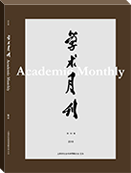Citation:
Minimum Wage Regulation and Chinese Enterprises[J]. Academic Monthly, 2018, 50(03).

Minimum Wage Regulation and Chinese Enterprises
-
Abstract
As a powerful policy to maneuver the labor market, minimum wage regulation inevitably influences business activities. Based on the firm-level panel data covering all above-designated-sized industrial companies from 1998 to 2007, together with the district or county level minimum wages data, this paper utilizes a survival analysis to examine the impact of minimum wage regulation on business exit in China. The results show that minimum wage increases labor costs, forces companies to withdraw faster, and affects the survival chances through the compression of enterprise human-capital investment rather than that of fixed-capital expansion. A further discussion finds that, compared with non-union enterprises, firms with unions can better transmit voices from workers, reduce internal cost, and decrease the likelihood of exit. Among companies with various sizes and different types of ownership, minimum wage regulation has different effects on the survival rate. Further research indicates that minimum wage regulation partly plays a cleansing role, and, while forcing inefficient enterprises to exit, saves more market space and creates opportunities for efficient ones. This study not only objectively assesses the impact of the minimum wage regulation on the survival of industrial enterprises, but also provides important insights for Chinese enterprises to actively respond to labor market policies and achieve vitality construction
-

-
References
-
Access
-
-
[1]
Ninghua ZHONG
, Wanyi CHEN
, Mi XIE
. Features and Recent Evolution of Corporate Debt in China. Academic Monthly,
2021, 53(10): 77-87.
-
[2]
,
. . Academic Monthly,
2016, 48(08): 61-70.
-
[3]
Miaojie YU
, Xiaotong WANG
. China-ASEAN Free Trade Agreement and Chinese Enterprise Productivity. Academic Monthly,
2021, 53(3): 50-62.
-
[4]
. . Academic Monthly,
2017, 49(01): 42-56.
-
[5]
Pengcheng ZHENG
. From the Taxes System to Market Mechanism: The Transformation of Mountain Land Property Rights in Yongfu County in Ming-Qing Period. Academic Monthly,
2023, 55(3): 187-196.
-
[6]
LI Jingkui
. Labor Contract Law,Enterprise Boundary and New Labor Dual Market. Academic Monthly,
2023, 55(8): 61-79.
-
[7]
Canfa WANG
, Yutong WANG
. Research on the Jurisprudence, Risks and Regulation of Judicial Application of “Green Principle”. Academic Monthly,
2023, 55(3): 93-107.
-
[8]
Zhiyang LIU
, Lufeng WANG
. The Emergence Logic of Social Enterprise in China. Academic Monthly,
2019, 51(10): 82-91.
-
[9]
Dapeng ZHOU
. Entrepreneurship and Schumpeterian Growth and Transformation of China’s Economy. Academic Monthly,
2020, 52(7): 57-68.
-
[10]
CHEN Binkai
. The Regulation and Liberalization of Chinese Interest Rate System. Academic Monthly,
2024, 56(2): 66-93.
-
[11]
,
,
. . Academic Monthly,
2017, 49(03): 48-60.
-
[12]
. . Academic Monthly,
2016, 48(11): 95-107.
-
[13]
,
,
. . Academic Monthly,
2016, 48(10): 55-66.
-
[14]
,
,
. . Academic Monthly,
2017, 49(06): 74-82.
-
[15]
,
,
. . Academic Monthly,
2016, 48(03): 37-47.
-
[16]
Shiyi CHEN
, Chaoliang LIU
, Hao JIN
. Environmental Regulation, Labor Allocation and High-Quality Urban Development. Academic Monthly,
2022, 54(2): 48-62.
-
[17]
. . Academic Monthly,
2016, 48(06): 76-84.
-
[18]
Xiang WEN
. Sociological Narratives of the Globalization of the Art Market : Performance, Mechanisms and Consequences. Academic Monthly,
2022, 54(8): 118-128.
-
[19]
,
. . Academic Monthly,
2016, 48(12): 75-85.
-
[20]
WEN Xiang
. Art Market Research and Discipline Construction of Art Sociology. Academic Monthly,
2023, 55(6): 116-124.
-
-



 沪公网安备 31010102003103号
沪公网安备 31010102003103号 DownLoad:
DownLoad: